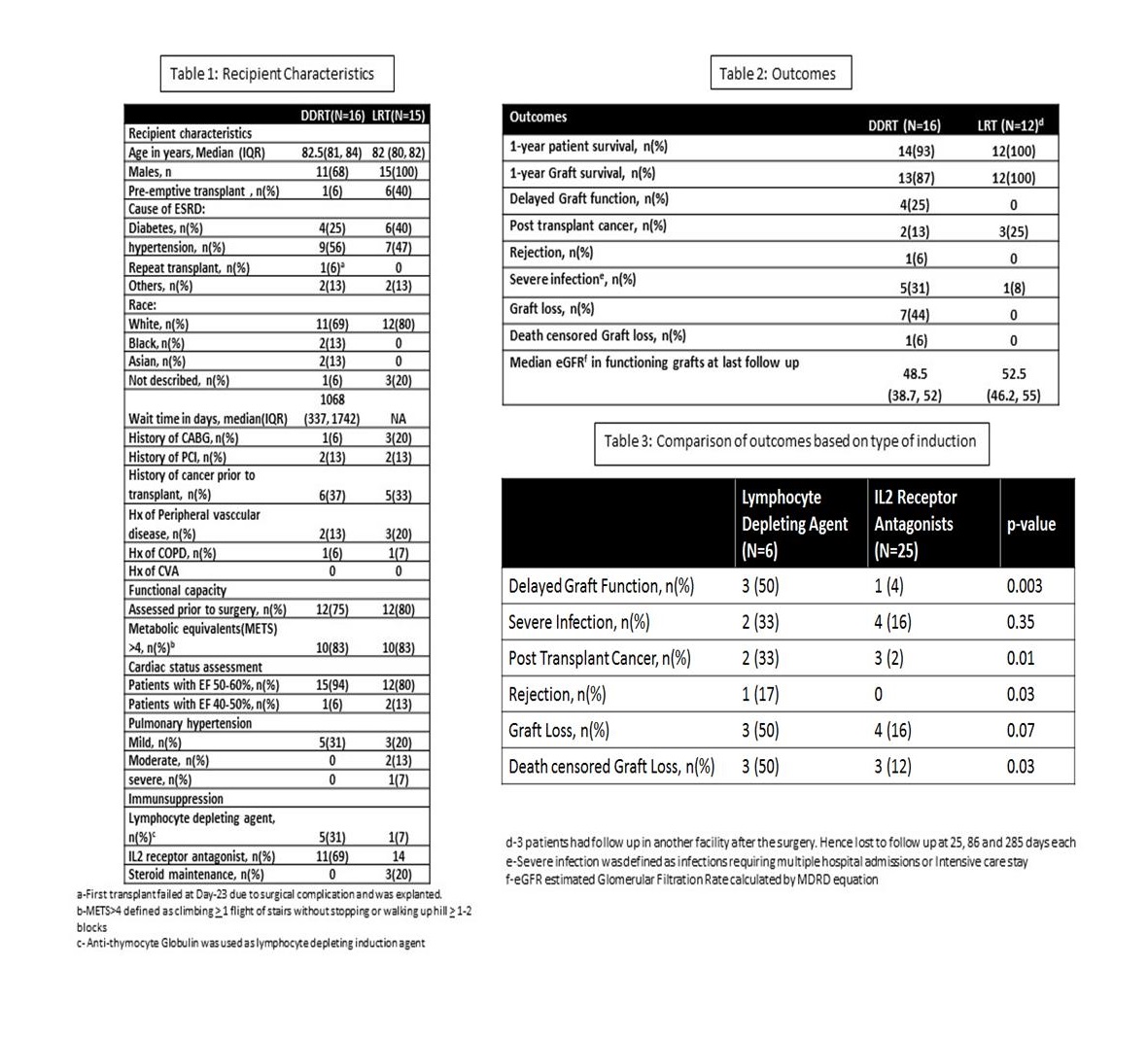80 is the New 60: A Single-Center Outcome Study of Octogenarian Kidney Transplant Recipients
Weill Cornell Medicne, New York City, NY
Meeting: 2020 American Transplant Congress
Abstract number: C-236
Keywords: Age factors, Elderly patients, Kidney transplantation, Outcome
Session Information
Session Name: Poster Session C: Non-Organ Specific: Disparities to Outcome and Access to Healthcare
Session Type: Poster Session
Date: Saturday, May 30, 2020
Session Time: 3:15pm-4:00pm
 Presentation Time: 3:30pm-4:00pm
Presentation Time: 3:30pm-4:00pm
Location: Virtual
*Purpose: Kidney transplantation is the treatment of choice for end stage renal disease. However, limited data is available on the outcomes of octogenarian recipients.
*Methods: Retrospective chart review of octogenarian recipients who underwent kidney transplant at Weill Cornell Medical center from 2008 to 2018.
*Results: Of the 31 patients analyzed (table1), 16 transplants were from deceased donors (DDRT) whereas 15 were from live donors (LRT). Majority were males (83%) and Caucasians (74%). There was no perioperative mortality. Three LRT were lost to follow up. The median follow-up time was 798 days (IQR 406, 1498). Death censored median follow up was 619 days (IQR 380, 1358). The median wait time for DDRT was 1068 days (IQR 337, 1742). Five of 15 LRT had prior history of cancer (3 skin, 1 prostate, 1 had history of multiple cancers) whereas 6 of 16 DDRT had prior history of cancer (2 renal cell, 2 prostate, 2 breast). Majority of patients received IL2 receptor antagonist (IL2RA) for induction. Three LRT were maintained on triple drug regimen of tacrolimus, mycophenolate mofetil and steroids. The remaining recipients received dual immunosuppression without steroids. One-year patient survival was 93% in DDRT and 100% in LRT (Table 2). One-year graft survival was 87% in DDRT and 100% in LRT group. Only 4 DDRT had delayed graft function(DGF) (13% overall). The rejection rate was low at 3% during follow-up. Three LRT (2 skin cancer, 1 myelodysplastic syndrome) and 2 DDRT (1 skin cancer, 1 multiple myeloma that was not amenable to treatment) had post-transplant malignancy. There were 7 graft loss, all in the DDRT cohort. Death censored graft loss was 6%. Among the functioning grafts, median eGFR in mL/min/1.73m2 at last follow up was 48.5 in DDRT and 52.5 in the LRT cohort. Comparison of outcomes based on induction agent (table 3) showed significantly more DGF(p=0.003), post-transplant malignancy(p=0.01), acute rejection(p=0.03) and death censored graft loss (p=0.03) in recipients who received lymphocyte depleting agent compared to IL2RA.
*Conclusions: The one-year patient and graft survival for LRT octogenarian kidney transplant recipients were similar to younger recipients. However, graft and patient survival were inferior following DDRT. Although limited by small sample, using lymphocyte depleting agent resulted in inferior outcomes when compared to IL2RA in our recipients.
To cite this abstract in AMA style:
Shankaranarayanan D, Muthukumar T, Sultan S, Watkins A, Serur D, Hartono C. 80 is the New 60: A Single-Center Outcome Study of Octogenarian Kidney Transplant Recipients [abstract]. Am J Transplant. 2020; 20 (suppl 3). https://atcmeetingabstracts.com/abstract/80-is-the-new-60-a-single-center-outcome-study-of-octogenarian-kidney-transplant-recipients/. Accessed December 12, 2025.« Back to 2020 American Transplant Congress

